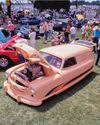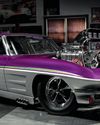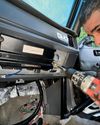
We spent a couple of days at JMS Racing Engines, in El Monte, California, talking with owner Mike Johnson and his machinists and builders to get the scoop on what makes a successful budget performance-engine build. We’re assuming that you’re starting with an engine that is in good condition and hasn’t had more than one overbore, you plan to reuse as many of the stock components as you can, upgrading to higher-performance pieces as your budget permits, and you do the disassembly and reassembly yourself. As with any complicated process like this there are plenty of myths to bust, and just as many procedures to follow. We’ll break everything down into bite-sized pieces.
Source
JMS Racing Engines; El Monte, CA; 626/579-4567; jmsracing.com
Devise a Plan
We cannot stress this enough—the most important part of any engine build begins with a good plan. By good we mean one that is realistic and fits within your budget. Ask yourself: What do you have to work with, and how much can you afford to spend? Are you starting with a lightly used original bore stock block that just needs new rings, bearings, and a hone, or are you starting with a “mystery motor” of unknown origin? We’ve all heard those stories of free engines that were guaranteed to run but, upon closer inspection, needed a lot of work.
Bu hikaye Hot Rod dergisinin December 2020 sayısından alınmıştır.
Start your 7-day Magzter GOLD free trial to access thousands of curated premium stories, and 9,000+ magazines and newspapers.
Already a subscriber ? Giriş Yap
Bu hikaye Hot Rod dergisinin December 2020 sayısından alınmıştır.
Start your 7-day Magzter GOLD free trial to access thousands of curated premium stories, and 9,000+ magazines and newspapers.
Already a subscriber? Giriş Yap

What Is Pro Street?
You know it when you see it.

Pro Street in Pure Vision
Builder Steve Strope weighs in on the Pro Street look and what he would build today.

THE GAS ERA LIVES ON
These vintage race cars chart the evolution of technology in the early days of drag racing.

MOTOR HEAD FOR LIFE
Scott Sullivan is one of the original Pro Street pioneers. He still builds cars today out of a small shop in Dayton, Ohio.

BRINGING BACK PRO STREET!
David Freiburger and Roadkill Garage built a Pro Street Nova.

SWEET ASPIRATIONS
Jerry and Matthew Sweet added an 800ci Pro Stock mountain motor to chase HOT ROD Drag Week's Pro Street NA Record.

Making Bad Decisions Badder
Bradley Gray's 1970 Nova is a Hybrid! It's a streetable Funny Car.

ART PROJECT
This Rad Rides by Troy-built '63 split-window Corvette went from restaurant prop to ripping up the street!

WHERE DO WE GO FROM HERE?
THE PRO STREET ERA PEAKED IN THE '80S. ARE WE IN THE BEGINNING OF A RESURGENCE?

Making Connections
Project T-top Coupe: We install a Terminator X Max for big power.